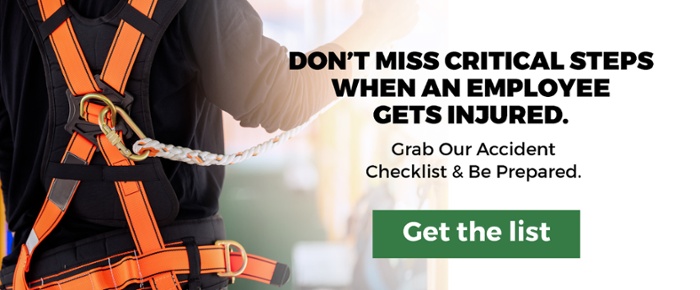
Need a Construction incident report?
When something goes wrong at your site, the smallest details suddenly become the most important.
Combining the facts of an incident into a useful write-up can be tricky, but this skill is essential to making sure your report is thorough and serves its purpose. Let’s talk about what you need to know when building a construction incident report.
Getting your incident report right
The words “incident” and “accident” don’t always mean the same thing. For example, OSHA chooses to avoid the word “accident” in its forms and materials. Your organization and state may have its own ways of categorizing these events, but a general rule of thumb is that an incident is any mistake that causes a loss of productivity or materials, which could also be called a “near miss.” In contrast, any incident that causes severe damage, injury, or loss of life is considered an accident, regardless of cause.
It’s important to know the distinction. The way you describe an incident can impact what your organization learns from the event and the safety measures that may be put in place as a result. Every unwanted incident is a learning opportunity and a chance to prevent greater loss down the road.
Writing an incident report
Because the information for your incident report is so vital for future planning, you’ll want to make sure that your final document is easy to read, thorough, and insightful. Start by reviewing as many relevant sources as possible.
Gather the Facts
An essential first step, gathering the facts will help you build a picture of the incident, the circumstances surrounding it, and other necessary context. This makes it easier to find the root of the problem. Document the date and time, location, the employees, machinery, or equipment involved, and any previously known issues.
For example, did the incident occur during a shift change, or because of a missed training? This step will likely require you to interview employees and witnesses, take photos of the incident area, and check camera footage or other recordings if possible.
Crucially, if an employee is killed on the job or suffers a work-related hospitalization, amputation, or loss of an eye, OSHA must be notified. In this case, time is of the essence and your report must be filed and submitted quickly.
Build the Event Sequence
Once you have all the facts, you can start building a timeline of the incident, from start to finish. This step-by-step sequence ensures that the report contains as much detail as possible, while still being readable and easy to follow. Include steps that led to the incident (such as unexpected weather, communication issues, etc.) the events of the incident itself (answer the key questions of who, what, when, and where) and what happened immediately following the incident (were emergency services called, did employees know how to use emergency protocols or equipment, how were higher-ups alerted, etc.).
This timeline will probably be the most demanding part of your report—it is, after all, the most important. Without a properly determined sequence of events, it can be impossible to find the “why” and the “how” of an incident to prevent it from recurring.
Determine Cause
Once your event sequence has given you insight into the incident, analyze the facts you’ve assembled to help you determine the cause. Depending on the size of your site and the severity of the incident, it can be helpful to work through this step with your safety team or with a safety consultant. A fresh pair of eyes might be able to spot holes in your current safety plan that have gone unnoticed.
Remember, there may not be a single cause for the incident, so it’s important to include other possible causes. For example, after an employee suffers a fall, this incident might be traced back to a spill on the floor, the employee failing to wear non-slip shoes, and maybe even inadequate lighting in the area.
Make a Recommendation
Once you’ve gathered the facts, sequenced them, and determined key potential causes, you will be able to make a recommendation. This may be a difficult step, depending on your company’s setup. If your organization doesn’t have a dedicated safety team, a safety consultant can help you turn the facts of an incident into actionable steps to keep you safer in the future.
SafetyPro can help with Incident Reports & how to avoid the, Talk to us today
What are the Steps of a Corrective Action Plan?
However you arrive at a recommendation, it should include specific corrective action that targets the factors that caused the incident. This might be preventative maintenance work, an equipment checklist, or a safety audit to review procedures. You will likely need to develop a corrective action plan that ensures accountability, efficiency, and effectiveness. A corrective action plan also demonstrates to OSHA that you are working to address current issues that may be noted during a surprise inspection.
Address Incidents with the help of a safety consultant
As industry experts with years of experience developing unique plans to address any site's needs, your safety consultant has the expertise to improve safety and decrease associated costs. Current knowledge of regulations and upcoming changes keeps you ahead of the safety curve with a flexible system and skilled implementation partner.
In addition to reducing the safety-associated costs, a good safety record can improve your bottom line by indicating you are a low-risk, high-productivity job partner. With a stronger brand value and community standing, you develop a competitive edge that can increase your market share. With the help of a safety consultant, it is possible to create a win-win scenario and a healthy ROI on your safety investment.
Learn more about our Safety Programs and the safety services we offer at SafetyPro, check out these services pages:
and all our services here: Safety Management Services from SafetyPro


















